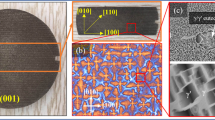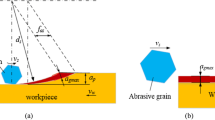Abstract
Based on the variation of the actual cutting depth during the grinding process, a 3D finite element simulation model for grinding nickel-based superalloy GH4169 with single abrasive was initially constructed. Then, the morphological evolution of the grinding chips during the grinding process was studied. In addition, the effect of the single abrasive cutting depth and the grinding speed on chip morphology and segmentation frequency were investigated. Finally, experimental results with the same test parameters verify the finite element simulation results. The results showed that in the experimental grinding speed range, the sawtooth lamellar chip with the free surface being serrated and the contact surface being smooth due to the extrusion of the abrasive are easy to produce when grinding nickel-based superalloy GH4169. As the grinding speed increases, the chip morphology changes from a unitary lamellar chip to a continuous serrated chip, developing into a continuous ribbon chip. The chip segmentation frequency is mainly determined by grinding depth and grinding speed. To be specific, the smaller the grinding depth and the greater the grinding speed, the greater the chip formation frequency.















Similar content being viewed by others
References
Gong YD, Zhou YG, Wen XL, Cheng J, Sun Y, Ma LJ (2017) Experimental study on micro-grinding force and subsurface microstructure of nickel-based single crystal superalloy in micro grinding. J Mech Sci Technol 31:3397–3410. https://doi.org/10.1007/s12206-017-0629-8
Miao Q, Ding WF, Kuang WJ, Yang CY (2020) Comparison on grindability and surface integrity in creep feed grinding of gh4169, k403, dz408 and dd6 nickel-based superalloys. J Manuf Process 49:175–186. https://doi.org/10.1016/j.jmapro.2019.11.027
Dai CW, Yu TY, Ding WF, Xu JH, Yin Z, Li H (2019) Single diamond grain cutting-edges morphology effect on grinding mechanism of Inconel 718. Precis Eng 55:119–126. https://doi.org/10.1016/j.precisioneng.2018.08.017
Dai CW, Ding WF, Zhu YJ, Xu JH, Yu HW (2017) Grinding temperature and power consumption in high speed grinding of Inconel 718 nickel-based superalloy with vitrified CBN wheels. Precis Eng. https://doi.org/10.1016/j.precisioneng.2017.12.005
Cai M, Gong YD, Sun Y, Qu SS, Liu Y, Yang YY (2019) Experimental study on grinding surface properties of nickel-based single crystal superalloy dd5. Int J Adv Manuf Technol. 101:71–85. https://doi.org/10.1007/s00170-018-2839-3
Cai M, Gong YD, Qu SS, Yang YY (2019) Experiment of grinding surface quality and subsurface microstructure for nickel-based single crystal superalloy. J Northeast Univ 40(03):386–391. https://doi.org/10.12068/j.issn.1005-3026.2019.03.016
Ding WF, Dai CW, Yu TY, Xu JH, Fu YC (2017) Grinding performance of textured monolayer CBN wheels: undeformed chip thickness nonuniformity modeling and ground surface topography prediction. Int J Mach Tools Manuf 122:66–80. https://doi.org/10.1016/j.ijmachtools.2017.05.006
Ruzzi RDS, Paiva RLD, Silva LRRD, Abro AM, Silva RBD (2021) Comprehensive study on Inconel 718 surface topography after grinding. Tribol Int 158:106919. https://doi.org/10.1016/j.triboint.2021.106919
Li C, Piao YC, Meng BB, Hu YX, Li LQ, Zhang FH (2022) Phase transition and plastic deformation mechanisms induced by self-rotating grinding of GaN single crystals. Int J Mach Tools Manuf. https://doi.org/10.1016/j.ijmachtools.2021.103827
Qu SS, Yao P, Gong YD, Yang YY, Chu DK, Zhu QS (2021) Modelling and grinding characteristics of unidirectional C-SiCs. Ceram Int. https://doi.org/10.1016/j.ceramint.2021.12.036
Zhang ZY, Wang B, Kang R, Zhang B, Guo DM (2015) Changes in surface layer of silicon wafers from diamond scratching. CIRP Ann Manuf Technol 64(1):349–352. https://doi.org/10.1016/j.cirp.2015.04.005
Wang B, Zhang ZY, Chang KK, Cui JF, Andreas R, Yu JH, Lin CT, Chen GX, Zang KT, Luo J, Jiang N, Guo DM (2018) New deformation-induced nanostructure in silicon. Nano Lett 18:4611–4617. https://doi.org/10.1021/acs.nanolett.8b01910
Zhang ZY, Guo DM, Wang B, Kang RK, Zhang B (2015) A novel approach of high speed scratching on silicon wafers at nanoscale depths of cut. Sci Rep 5:16395. https://doi.org/10.1038/srep16395
Zhang ZY, Song YX, Xu CG, Guo DM (2012) A novel model for undeformed nanometer chips of soft-brittle hgcdte films induced by ultrafine diamond grits. Scr Mater 67(2):197–200. https://doi.org/10.1016/j.scriptamat.2012.04.017
Zhang ZY, Huo FW, Zhang XZ, Guo DM (2012) Fabrication and size prediction of crystalline nanoparticles of silicon induced by nanogrinding with ultrafine diamond grit. Scr Mater 67:657–660. https://doi.org/10.1016/j.scriptamat.2012.07.016
Zhang ZY, Cui JF, Wang B, Wang ZG, Kang RK, Guo DM (2017) A novel approach of mechanical chemical grinding. J Alloys Compd 726:514–524. https://doi.org/10.1016/j.jallcom.2017.08.024
Öpöz TT, Chen X (2012) Experimental investigation of material removal mechanism in single grit grinding. Int J Mach Tools Manuf 63:32–40. https://doi.org/10.1016/j.ijmachtools.2012.07.010
Öpöz TT, Chen X (2014) Experimental study on single grit grinding of Inconel 718. Procee Ins Mech Eng Part B J Eng Manuf. https://doi.org/10.1177/0954405414531114
Chen X, Öpöz TT (2013) Comparison of material removal characteristics in single and multiple cutting edge scratches. Adv Mat Res 797:189–195. https://doi.org/10.4028/www.scientific.net/AMR.797.189
Zhao JY, Yu CF, Xu JH, Lin T, Lu Y (2013) Forces and chip morphology of nickel-based superalloy Inconel 718 during high speed grinding with single grain. Key Eng Mater 589–590:209–214. https://doi.org/10.4028/www.scientific.net/KEM.589-590.209
Chen ZZ, Tian L, Fu YC, Xu JH, Ding WF, Su HH (2012) Chip formation of nickel-based superalloy in high speed grinding with single diamond grit. Int J Abras Technol 5(2):93–106. https://doi.org/10.1504/IJAT.2012.048537
Tian L, Fu YC, Xu JH, Li HY, Ding WF (2015) The influence of speed on material removal mechanism in high speed grinding with single grit. Int J Mach Tools Manuf 89:192–201. https://doi.org/10.1016/j.ijmachtools.2014.11.010
Feng BF, Cai GQ, Sun XL (2006) Groove, chip and force formation in single grain high-speed grinding. Key Eng Mater 304–305:196–200. https://doi.org/10.4028/www.scientific.net/KEM.304-305.196
Ruzzi RDS, Silva RBD, Silva LRRD, Machado AR, Jackson MJ, Hassui A (2020) Influence of grinding parameters on Inconel 625 surface grinding. J Manuf Process 55:174–185. https://doi.org/10.1016/j.jmapro.2020.04.002
Li BK, Dai CW, Ding WF, Yang CY, Shumyacher V (2020) Prediction on grinding force during grinding powder metallurgy nickel-based superalloy fgh96 with electroplated CBN abrasive wheel. Chinese J Aeronaut. https://doi.org/10.1016/j.cja.2020.05.002
Denkena B, Köhler J, Kästner J (2012) Chip formation in grinding: an experimental study. Prod Eng Res Devel 6:107–115. https://doi.org/10.1007/s11740-011-0360-8
Brinksmeier E, Aurich JC, Govekar E, Heinzel C, Hoffmeister HW, Klocke F, Peters J, Rentsch R, Stephenson DJ, Uhlmann E, Weinert K, Wittmann M (2006) Advances in modeling and simulation of grinding processes. CIRP Ann 55(2):667–696. https://doi.org/10.1016/j.cirp.2006.10.003
Fu DK, Ding WF, Miao Q, Xu JH (2017) Simulation research on the grinding forces and stresses distribution in single-grain surface grinding of ti-6al-4v alloy when considering the actual cutting-depth variation. Int J Adv Manuf Technol 91:3591–3602. https://doi.org/10.1007/s00170-017-0084-9
Dai JB, Ding WF, Zhang LC, Xu JH, Su HH (2015) Understanding the effects of grinding speed and undeformed chip thickness on the chip formation in high-speed grinding. Int J Adv Manuf Technol 81:995–1005. https://doi.org/10.1007/s00170-015-7265-1
Zhou WB, Su HH, Dai JB, Yu TF, Zheng YH (2018) Numerical investigation on the influence of cutting-edge radius and grinding wheel speed on chip formation in sic grinding. Ceram Int 44:21451–21460. https://doi.org/10.1016/j.ceramint.2018.08.206
Xia J, Ding WF, Qiu B, Xu JH (2020) 3D simulation study on the chip formation process in high speed and ultra-high speed grinding of nickel-based superalloy. Diamond Abras Eng 40(06):58–69. https://doi.org/10.13394/j.cnki.jgszz.2020.6.0011
Funding
This work was supported by the National Natural Science Foundation of China (Nos. U1908230&51775100), the Science and Technology Research Project of the Educational Department of Liaoning Province (Nos. LJKZ0384&L2017LQN024), and the Talent Scientific Research Fund of LNPU (No. 2021XJJL-007).
Author information
Authors and Affiliations
Contributions
Tao Zhu: Writing-original draft, software, investigation, visualization. Ming Cai: Writing-original draft, review and editing, conceptualization, funding, visualization. Yadong Gong: Conceptualization, methodology, formal analysis. Xingjun Gao: Supervision, investigation, methodology. Ning Yu: Data curation, formal analysis. Xiang Li: Data curation, formal analysis.
Corresponding author
Ethics declarations
Competing interests
The authors declare no competing interests.
Additional information
Publisher's Note
Springer Nature remains neutral with regard to jurisdictional claims in published maps and institutional affiliations.
Rights and permissions
About this article
Cite this article
Zhu, T., Cai, M., Gong, Y. et al. Study on chip formation in grinding of nickel-based polycrystalline superalloy GH4169. Int J Adv Manuf Technol 121, 1135–1148 (2022). https://doi.org/10.1007/s00170-022-09386-8
Received:
Accepted:
Published:
Issue Date:
DOI: https://doi.org/10.1007/s00170-022-09386-8




